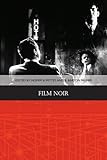Film Noir / Homer B. Pettey, R. Barton Palmer.
Material type: TextSeries: Traditions in American Cinema : TACPublisher: Edinburgh : Edinburgh University Press, [2022]Copyright date: ©2014Description: 1 online resource (240 p.) : 25 B/W illustrationsContent type:
TextSeries: Traditions in American Cinema : TACPublisher: Edinburgh : Edinburgh University Press, [2022]Copyright date: ©2014Description: 1 online resource (240 p.) : 25 B/W illustrationsContent type: - 9780748691074
- 9780748691081
- 791.43/6556 23
- online - DeGruyter
| Item type | Current library | Call number | URL | Status | Notes | Barcode | |
|---|---|---|---|---|---|---|---|
 eBook
eBook
|
Biblioteca "Angelicum" Pont. Univ. S.Tommaso d'Aquino Nuvola online | online - DeGruyter (Browse shelf(Opens below)) | Online access | Not for loan (Accesso limitato) | Accesso per gli utenti autorizzati / Access for authorized users | (dgr)9780748691081 |
Frontmatter -- CONTENTS -- List of Illustrations -- Acknowledgements -- Notes on the Contributors -- Introduction: The Noir Turn -- 1. The Cinema of Uncertainty and the Opacity of Information from Louis Feuillade’s Crime Serials to Film Noir -- 2. Warning Shadows: German Expressionism and American Film Noir -- 3. Hard-boiled Tradition and Early Film Noir -- 4. Cold War Noir -- 5. Noiring the Pitch: The Conflicted Soundtracks of Out of the Past, The Blue Gardenia and The Long Goodbye -- 6. Split Screen: Sound/Music in The Stranger/Criss Cross -- 7. Gender and Noir -- 8. The Subversive Shade of Black in Film Noir -- Postscript: A History of Our Writing about Film Noir -- Selected Book Chapters on Film Noir -- Selected Film Noir Books -- Selected Guide to Film Noir -- Index
restricted access online access with authorization star
http://purl.org/coar/access_right/c_16ec
Explores the development of film noir as a cultural and artistic phenomenonThis book traces the development of what we know as film noir from the proto-noir elements of Feuillade’s silent French crime series and German Expressionism to the genre’s mid-twentieth century popularization and influence on contemporary global media.By employing experimental lighting effects, oblique camera angles, distorted compositions, and shifting points-of-view, film noir’s style both creates and comments upon a morally adumbrated world, where the alienating effects of the uncanny, the fetishistic, and the surreal dominate. What drew original audiences to film noir is an immediate recognition of this modern social and psychological reality. Much of the appeal of film noir concerns its commentary on social anxieties, its cynical view of political and capitalist corruption, and its all-too-brutal depictions of American modernity. This book examines the changing, often volatile shifts in representations of masculinity and femininity, as well as the genre’s complex relationship with Afro-American culture, observable through noir’s musical and sonic experiments.Key FeaturesTraces the history of film noir from its aesthetic antecedents through its mid-century popularization to its influence on contemporary global media Discusses the influence of literary and artistic sources on the development of film noirIncludes extensive bibliographies, filmographies and recommended noir film viewingConcludes with a reflective chapter by Alain Silver and James Ursini on their own influential studies and collections on film noir criticism
Mode of access: Internet via World Wide Web.
In English.
Description based on online resource; title from PDF title page (publisher's Web site, viewed 29. Jun 2022)


